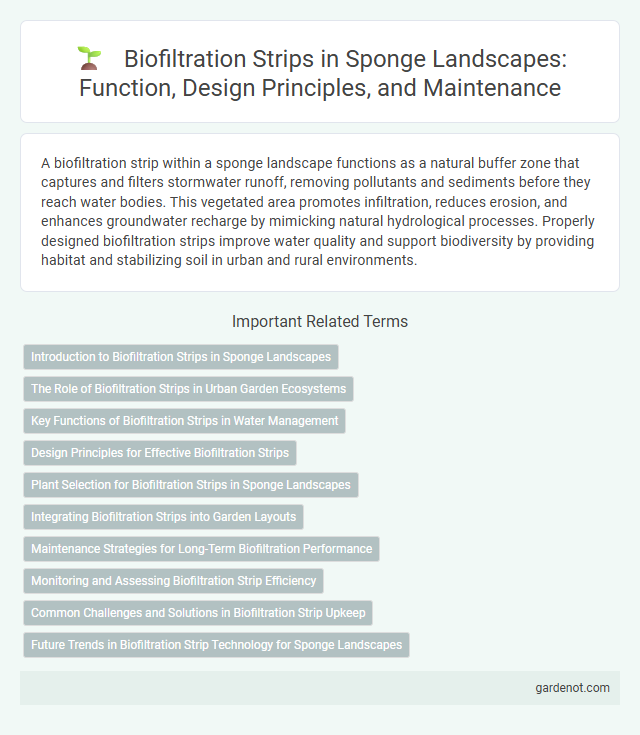A biofiltration strip within a sponge landscape functions as a natural buffer zone that captures and filters stormwater runoff, removing pollutants and sediments before they reach water bodies. This vegetated area promotes infiltration, reduces erosion, and enhances groundwater recharge by mimicking natural hydrological processes. Properly designed biofiltration strips improve water quality and support biodiversity by providing habitat and stabilizing soil in urban and rural environments.
Introduction to Biofiltration Strips in Sponge Landscapes
Biofiltration strips in sponge landscapes function as vegetated zones designed to capture and treat stormwater runoff, enhancing water quality and reducing pollution. These strips utilize native plants and engineered soil media to filter sediments, nutrients, and contaminants before water infiltrates the ground or reaches water bodies. Implementing biofiltration strips contributes to sustainable urban drainage systems by promoting groundwater recharge and mitigating flood risks.
The Role of Biofiltration Strips in Urban Garden Ecosystems
Biofiltration strips in urban garden ecosystems enhance water quality by filtering pollutants from stormwater runoff through vegetation and soil media. These strips support biodiversity by providing habitat for beneficial microorganisms and insects that contribute to nutrient cycling and soil health. Their integration into sponge landscapes reduces urban flooding risks while promoting sustainable, eco-friendly urban spaces.
Key Functions of Biofiltration Strips in Water Management
Biofiltration strips play a critical role in sponge landscape water management by filtering pollutants, sediments, and nutrients from stormwater runoff before it enters natural water bodies. They enhance groundwater recharge and reduce surface water flooding by promoting infiltration through layers of vegetation and soil. Key functions include improving water quality, mitigating erosion, and supporting habitat diversity within urban and peri-urban environments.
Design Principles for Effective Biofiltration Strips
Biofiltration strips in sponge landscapes are designed with permeable soil media that enhance water infiltration and pollutant removal. Vegetation selection prioritizes native plants with deep roots to maximize contaminant uptake and stabilize soil structure. Effective biofiltration design integrates proper slope gradients to optimize flow distribution and prevent erosion while maintaining sufficient retention time for microbial degradation.
Plant Selection for Biofiltration Strips in Sponge Landscapes
Selecting native, water-tolerant plants like Carex, Juncus, and Scirpus species enhances the effectiveness of biofiltration strips in sponge landscapes by maximizing pollutant uptake and soil stabilization. Deep-rooted perennial grasses and wetland plants improve infiltration rates and provide habitat diversity while tolerating periodic flooding. Optimal plant selection supports nutrient cycling, sediment capture, and microbial activity essential for maintaining water quality and reducing runoff in urban environments.
Integrating Biofiltration Strips into Garden Layouts
Integrating biofiltration strips into garden layouts enhances water management by naturally filtering runoff through native plants and engineered soil media. Strategically positioning these vegetated strips along slopes or near water bodies reduces pollutants and supports biodiversity within the sponge landscape framework. Enhanced soil permeability and plant root systems improve drainage efficiency, mitigating flood risks while promoting a sustainable ecosystem.
Maintenance Strategies for Long-Term Biofiltration Performance
Regular maintenance of biofiltration strips involves periodic inspection and removal of accumulated sediments, ensuring optimal hydraulic conductivity and pollutant removal efficiency. Vegetation management, including selective pruning and replanting of native species, preserves root structure health and promotes microbial activity essential for nutrient cycling. Implementing adaptive maintenance schedules based on seasonal variations and monitoring water quality parameters enhances the long-term resilience and effectiveness of biofiltration systems.
Monitoring and Assessing Biofiltration Strip Efficiency
Monitoring and assessing biofiltration strip efficiency involves regularly measuring parameters such as pollutant removal rates, flow velocity, and vegetation health to ensure optimal performance. Utilizing sensors and remote sensing technology allows for real-time data collection on nutrient capture, sediment retention, and microbial activity within the sponge landscape. Data-driven analysis supports adaptive management strategies that enhance the biofiltration strip's capacity to improve water quality and mitigate urban runoff impacts.
Common Challenges and Solutions in Biofiltration Strip Upkeep
Biofiltration strip upkeep often faces challenges such as clogging from sediment buildup, uneven plant growth, and difficulty in maintaining optimal moisture levels. Regular monitoring and manual removal of debris, combined with strategic plant selection and soil amendments, can significantly improve water flow and pollutant removal efficiency. Implementing automated irrigation systems and periodic soil aeration helps maintain ideal conditions, enhancing the overall performance of the biofiltration strip.
Future Trends in Biofiltration Strip Technology for Sponge Landscapes
Future trends in biofiltration strip technology for sponge landscapes emphasize the integration of advanced microbial consortia to enhance pollutant degradation and water purification efficiency. Innovations in nanomaterial-infused substrates promote superior adsorption capacities and durability, addressing urban runoff challenges. Smart monitoring systems utilizing IoT and AI optimize maintenance, ensuring sustainable performance and adaptive biofiltration tailored to dynamic environmental conditions.
Biofiltration strip Infographic

 gardenot.com
gardenot.com